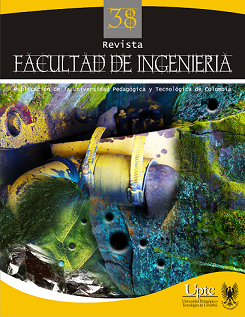A Technical and Environmental Study of Fortified Structures Used in Coal Mining in Norte de Santander

Abstract
The mechanic characterization of fortified structures on coal mining at Norte de Santander and the contribution of this sector to the deforestation have been poorly studied. The loss of forests zones between 1990 and 2010 was about 26%, however, the calculation shows that the coal mining sector contribution is only 0,36%. In total, were determined 17 geometric variables on the structures, but only two of them affect significantly their mechanical performance. A mechanical simulation and a 25experimental design were used to obtain a selection diagram of diameter and angle for the structures, which theoretically ensures a better use of wood. It could be used wood diameters as small as 14 cm, without compromising the mechanical properties of the design, leading to a possible shorter logging time, lower transport cost and easier assembly into the mine.Keywords
fortification structures, deforestation, coal mining, mechanical simulation
References
- República de Colombia, Ministerio de Minas, ABC Minero, 2012.
- República de Colombia, Ministerio de Minas, Censo Minero Departamental Colombiano. 2012.
- M. C. García Botero, Informe de gestión 2012. Bogotá: Grupo Edición Agencia Nacional Minera, 2012.
- R. J. Ferreras, C. G. Nicieza, A. M. Díaz, A. E. Vigil, and M. I. Álvarez, “Measurement and analysis of the roof pressure on hydraulic props in longwall”,Int. J. Coal Geol., vol. 75, no. 1, pp. 49-62, Jun. 2008.
- X. N. Tan and H. Qin, “Bolt support mechanism based on elastic theory”,Int. J. Min. Sci. Technol., vol. 23, no. 4, pp. 469-474, 2013.
- C. Banton, M. S. Diederichs, D. J. Hutchinson, and S. Espley, “Mechanisms of Shotcrete Roof Support”, in Taylor & F., E. S. Bernard, Tunnelling and Underground Space Technology, pp. 39–46 London, 2004.
- H. S. Mitri and F. P. Hassani, “Structural characteristics of coal mine steel arch supports,” Int. J. Rock Mech. Min. Sci. Geomech. Abstr., vol. 27, no. 2, pp. 121-127, Apr. 1990.
- C.A. Oztur, “Support design of underground openings in an asphaltite mine”. Tunnelling and Underground Space Technology, vol. 38, pp. 288-305, Sep. 2013.
- P. Forrest, E. Schumachera, “Modeling the pipe umbrella roof support system in a Western US underground coal mine”. International Journal of Rock Mechanics and Mining Sciences, Vol. 60, pp. 114-124. June 2013.
- Y. Kanga, Q. Liua, G. Gongc, H.Wangd, “Application of a combined support system to the weak floor reinforcement in deep underground coal mine”,International Journal of Rock Mechanics and Mining Sciences, vol. 71, pp. 143-150, 2014.
- E. Ghasemia, M. Ataeia, K. Shahriarb, F. Sereshkia, S. E. Jalalia, A. Ramazanzadeha,”Assessment of roof fall risk during retreat mining in room and pillar coal mines”, International Journal of Rock Mechanics and Mining Sciencesm, Vol. 54, pp. 80-89,Sep. 2012.
- Fedesarrollo, Pequeña y mediana minería de carbón del interior del país: alternativa de financiación y comercialización a partir de la conformación de las alianzas estratégicas, 2011. Disponible en: http://www.fedesarrollo.org.co/wp-content/uploads/2011/08/Peque%C3%B1ay-mediana-miner%C3%ADa-decarb%C3%B3n-del-interior-del-pa%C3%ADsInforme-final-19-de-diciembre.pdf.
- L. A. Arévalo, Manual para la identificación de maderas que se comercializan en el departamento de Tolima, ISBN: 958-33-8849-1, Ibagué, 2005.
- Sistema Nacional de Información Minero Colombiano, SIMCO, Producción y exportaciones de carbón relacionada con producción de carbón por departamentos, 2013. Disponible en: www.simco.gov.co
- F. Ortiz de Urbina, J. Herrera, Curso de Laboreo de Minas, Madrid, 2002.
- República de Colombia, Ministerio de Minas, Métodos de explotación minera. Dirección General de Minas, 2010.
- H. J. Vallares, Cálculo y diseño de entibaciones para excavaciones en profundidad. Tesis Ingeniero constructor. Valdivia Chile. Universidad Austral de Chile. Facultad de Ciencias de Ingeniería. Escuela de Construcción Civil, 2007.
- Departamento de Seguridad Minera, Guía metodológica de seguridad para sistemas de fortificación y acuñadura, Chile, 2010.
- L. M. Bermúdez, Caracterización mecánica del sistema de entibación de algunas minas tradicionales de carbón en Norte de Santander. Tesis Ingeniería Mecánica, Universidad de Pamplona, Colombia, 2013.
- N. Rozo, G. D. Marín, J. D. Giraldo, D. A. Cardona, J. M. Meza. “Ingeniería inversa de un arco recurvo compuesto”. VII Congreso internacional de Materiales. Medellín, 2013.
- M. F. Ashby, Materials Selection in Mechanical Design, 4° Edition. Butterworth-Heineman, Oxford, 2010.
- R.B. Barbero, “The recovery of design intent in reverse engineering problems”. Computers & Industrial Engineering. Vol. 56, No. 4, pp. 1265-1275. May 2009.
- República de Colombia, Instituto de Hidrología y Estudios Ambientales, IDEAM, Monitoreo de la deforestación mediante el procesamiento digital de imágenes, 2011. Disponible en: http://bitly.com/1vIB5jR.
- P. Box and S. Hunter,“Diseño factorial a dos niveles”. En: Estadística para investigadores, Cap. 10, Colombia: Ed. Reverté, pp. 317, 2002.
- State Easy, Manual General One-Factor Tutorial Design-Expert 8. Disponible en: http://www.qualitycoach.net/land/design-expert/tutorials/DX8-02A-Gen1Factor-P1.pdf.
Downloads
Download data is not yet available.